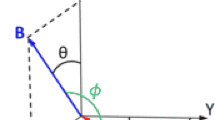Abstract
IN the course of ionospheric observations made during the International Polar Year 1932–33, a transient type of radio echo was observed from levels in the upper atmosphere about 100 km. above the ground. Such echoes were found to last only a second or two and were noted to be equally frequent both by day and by night. A solar origin in terms of ultra-violet radiation could thus be excluded, and it was pointed out that, possibly, the ionization trails of meteors were responsible, since Skellet had already noted major increases of abnormal E layer ionization to occur at night when meteors were observed to pass overhead.
Similar content being viewed by others
Author information
Authors and Affiliations
Rights and permissions
About this article
Cite this article
APPLETON, E., NAISMITH, R. Radar Detection of Meteor Trails. Nature 158, 936–938 (1946). https://doi.org/10.1038/158936a0
Issue Date:
DOI: https://doi.org/10.1038/158936a0
- Springer Nature Limited
This article is cited by
-
Rayonnement et propagation des ondes électromagnétiques de courte longueur d'onde
Annales Des Télécommunications (1948)
-
Radio Reflexions from Meteoric Ionization
Nature (1947)
-
Die Beobachtung von Meteoren durch Radiowellen
The Science of Nature (1947)





